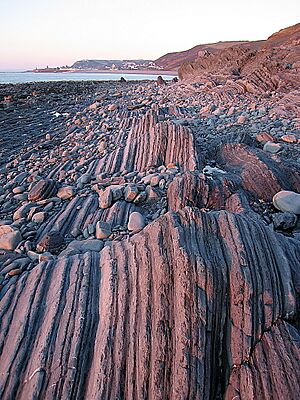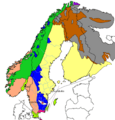Caledonian orogeny facts for kids

The Caledonian orogeny was a major period of mountain building on Earth. It created huge mountain ranges that are now found in parts of the British Isles, the Scandinavian Mountains, Svalbard, eastern Greenland, northern Europe, and the eastern United States.
These amazing events happened between 490 and 390 million years ago, during the Ordovician to early Devonian periods. The mountains formed when ancient continents and landmasses, called Laurentia, Baltica, and Avalonia, slowly moved towards each other and crashed. This collision caused the Iapetus Ocean to close up.
The Caledonian orogeny gets its name from Caledonia, which was the old Latin name for Scotland. It's important to remember that "Caledonian" doesn't mean a specific time period. Instead, it describes the series of mountain-building events that took place.
Some parts of these ancient mountain chains ended up in modern North America. There, this mountain-building event is known as the Acadian orogeny, and its remains can be seen in the Appalachian Mountains.
How the Mountains Formed
The Caledonian orogeny was one of several big mountain-building events. These events eventually led to the formation of a giant supercontinent called Pangaea much later in the Palaeozoic era.
The most active phase of the Caledonian mountain building happened about 425 to 395 million years ago. The slow collision of the continents began in the middle of the Silurian period. The main mountain-building process, where the land was pushed up to form peaks, continued into the early Devonian period, starting around 407 million years ago.
Images for kids
-
Geological map of Fennoscandia. The Sveconorwegian Orogen (including the Western Gneiss Region) is shown in pink. The nappes emplaced by the much younger Caledonian orogeny are shown in light green.
See also
 In Spanish: Orogenia caledoniana para niños
In Spanish: Orogenia caledoniana para niños



